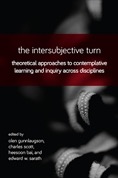intersubjectivity
Select an item by clicking its checkbox
Date Reviewed: April 15, 2020
Contemplative pedagogy has become quite popular over the past decade (Jacoby, 2019). This book builds on previous contemplative pedagogical scholarship (Barbezat and Bush, Contemplative Practices in Higher Education, Jossey-Bass, 2014; Simmer-Brown & Grace, Meditation and the Classroom, SUNY Press, 2011), especially a prior volume by the same editors—Contemplative Learning and Inquiry across Disciplines (Gunnlaugson et al., 2014). This book focuses on second-person perspectives or intersubjectivity, which the editors note can be represented spatially as between people, rather than subjectively inside or objectively outside them. It seeks to redress the tendency in contemplative studies to focus on first-person, personal experiences or third-person, objective study and observation of individuals engaged in contemplation.
The Intersubjective Turn would interest contemplative studies scholars as well as instructors with a previous background in contemplative pedagogy. Those unfamiliar with contemplative approaches to higher education would benefit from first consulting the work of Barbezat and Bush (Contemplative Practices in Higher Education, Jossey-Bass, 2014) or the previous volume (Gunnlaugson et al., Contemplative Learning and Inquiry across Disciplines, 2014), especially Arthur Zajonc’s overview of contemplative pedagogy in higher education and Harold Roth’s proposed pedagogy for contemplative studies. Although instructors who teach in public universities and colleges may find it challenging to adapt some of the contemplative approaches to their institutional context, those at private institutions and seminaries may encounter less difficulty in applying the contemplative pedagogies discussed.
Each article emphasizes the value of incorporating intersubjectivity into one’s contemplative pedagogy and focuses on particular classroom activities that promote such intersubjectivity. Mirabai Bush discusses her “Just Like Me” exercise developed for Google’s Search Inside Yourself program, where participants first engage in self-compassion and then become aware of what they share with others, and her “Mindful Emailing” activity where participants write a response to an email, but before sending it, lean back, take three deep breaths, re-read their response and imagine how it might be received by the other person. David Lee Keiser describes a pedagogical practice that addresses students’ discomfort at being stared at: a “stage exercise” where students mindfully walk to the front of the auditorium, pause and take a breath, make eye contact at least once with everyone in the room, then mindfully walk off stage, taking another breath and then returning to their seat.
Lyn Hartley advocates deep dialogue in which students explore uncertainties and questions that no one has answers to, which allows for transformative learning. Judith Simmer-Brown draws on Gregory Kramer’s method of “insight dialogue” to have students sit in dyads, reflecting on challenging aspects of their spiritual or personal journeys as they speak for three minutes and then return to silence and deep listening.
David Forbes uses mindfulness as a way for students to reflect on unexamined assumptions and conditioned patterns of thought in order to move towards a postconventional, self-authorized consciousness that tolerates ambiguity and agile thinking. Joanne Gozawa emphasizes the value of students not only doing contemplative practices, but “not doing” them by listening to silence and embodying a posture of receptivity. Other chapters discuss theological and theoretical reasons for engaging in intersubjective contemplative practices, advocating contemplative inquiry as a means of promoting empathetic connection.
